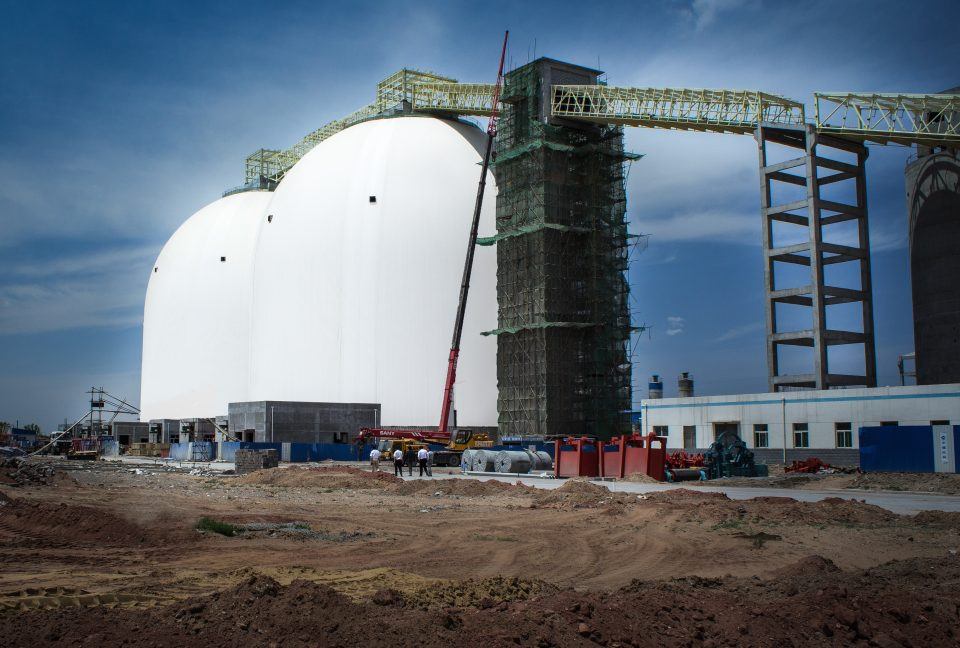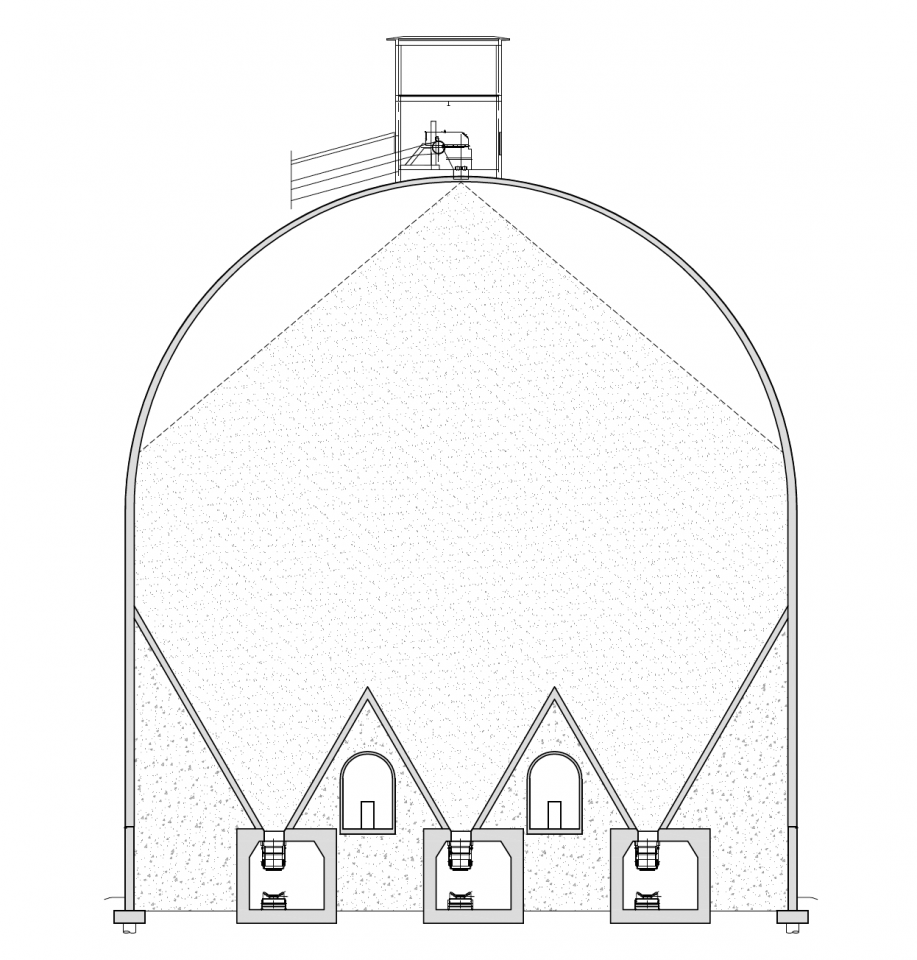When approached by a coal company needing to store coal at the mine and wanting to reclaim 100 percent of product without personnel entering the storage facility, the ideal model was clear.
A DomeSilo that’s 105 feet in diameter and 150 feet tall would provide the desired storage, and to make things work optimally, a full hopper system with chevrons 25 feet tall would be built directly into the dome, eliminating the need for mechanical systems inside.
“This doesn’t require any personnel inside the dome — there’s no mechanical inside the dome to go in and fix. The idea that we can make them really tall and skinny increases the live reclaim,” Dome Technology sales manager Lane Roberts said.
With chevrons hoppers into the dome, product flows easily by way of gravity. And when engineered to the optimal angle, cleaning out the dome is no problem at all, not to mention the likelihood of aging in pile is diminished as product is naturally first in, first out.
But a lot of behind-the-scenes work was required before settling on this customized model.

Engineering the best option
When the customer asked about the optimal guts for its coal storage dome, the first thing the Dome Technology team did was to suggest, based on experience, the number of tunnels thought to be best, which was three. But the second step was determining the lowest angle at which product would flow properly. This angle would determine the angle of chevrons within the dome.
After identifying the flow angle, Dome Technology calculated exactly how the company could save money while still achieving the reclaim and storage it wanted. The team tested different scenarios, changing up the number of tunnels and the number of chevrons but always keeping that flow angle in mind. After figuring the costs of the different models, the team was confident more tunnels would cost less than more chevrons.
Chevrons aren’t a cheap install; each one requires massive amounts of concrete and steel. Increasing the number of tunnels would mean the chevrons wouldn’t have to reach so high, dropping that cost substantially.
“We ran the model, and when we went down to two tunnels from three, the chevrons got so tall and the amount of concrete to form the chevrons doubled,” Roberts said, adding a quarter of a million in construction materials (not to mention labor increases).
Returning to the original recommendation of three tunnels would also provide greater storage since the taller the chevron, the more space it consumes inside the dome. Shorter chevrons free up room for product.
By finding the perfect balance — what number of tunnels best complements the appropriate chevron angle — companies like this can achieve necessary storage and save money. It’s the principle of design-build at its finest.

Why a full-hopper system works well for coal
The full-hopper system provides first-in, first out reclaim desirable with types of coal prone to spontaneous combustion. In general, domes are well suited for coal storage. DomeSilos make more storage possible within a smaller footprint — the facility is built up, not out — so companies can store more in a smaller footprint than warehouses or flat storage would allow. And the DomeSilo naturally protects product too — an important quality when working with volatile coal.
Fighting fire
One way to minimize the likelihood of fire is to select a bulk-storage option that inherently resists deflagration, and certain dome characteristics make fire less likely than in other storage facilities. A dome’s concrete shell is non-combustible and has low thermal conductivity, performing better in large fires than wood or even steel counterparts.
The insulated nature of the concrete shell, composed of polyurethane foam insulation and concrete placed using the shotcrete method, moderates externally generated temperature fluctuations, and the more constant an environment, the more stable otherwise volatile products will be. The dome’s insulated nature also reduces heating and cooling of the walls and air inside, thus preventing condensation from forming and introducing moisture to the product, which can result in self-heating.
The dome is airtight except wherever penetrations are made, aiding in the containment of inert gases pumped inside to deter fires and to minimize available oxygen for supporting fires. The truss-free structure discourages dust build-up, and the double curvature has proven in real-world examples that a dome is structurally stable under extreme fire and heat conditions. The structure itself can survive a disaster that other types of storage might not and will likely reward customers with insurance-premium savings.
Additional design features are key to fire prevention. With a thermal scanner over the belt on the inbound receiving side, infrared cameras check temperatures on coal, while on the belt, to make sure no off-spec product enters the dome. A linear heat cable monitors for fire on the belt, also examining bearings in case one is throwing sparks; this cable might detect a fire travelling along the belt length before it reaches the thermal scanner. A product unique to combustion-prone materials, this system shuts down conveyance and alerts facility management of the fire. Depending on the setup, workers can either extinguish the fire, or an existing fire-suppression system takes care of the problem.
Dealing with dust
A host of dust-control systems exist in the marketplace. One option is a spray-down system that literally sprays coal with water to wet the dust, preventing it from becoming airborne. Because water decreases coal’s useful BTU value, this system is not popular. One variation is to spray oil onto coal instead of water; the dust is still managed, but the useful BTU values are not reduced — though companies must assign a portion of the budget to purchasing mineral or vegetable oil.
To collect dust within the dome, a wet scrubber is preferred because it draws dust through a water system; since it is wet, the dust is not nearly as combustible. The dust is stored in a duct until it can be removed from the facility or destroyed. The scrubber is an attractive alternative to a baghouse system that sucks in air and pulls particulates through a fabric filter, thus collecting dust and storing it in a high concentration where the chance of combustion is still real.
Automatic dust-collection systems can be designed to convey dust away pneumatically via belt to a combuster. Alternately, dust can be collected in a bin or super sack to be hauled away.
Until now, square and rectangular explosion venting has been the norm in storing products prone to deflagration, but Dome Technology’s team has pioneered a round hybrid model that was installed on bulk-storage domes for two companies in 2016.
The proprietary explosion vents are comprised of a circular geodesic steel lattice covered with the same PVC fabric used in the dome construction process. The panel is anchored to the dome with explosion-venting relief screws that remain secure during the design dead, live and wind loads. But in the event of a deflagration event, the screws release the panel and allow for the release of the excessive internal pressure. The system is watertight and meets the required operational design loads.
When an explosion occurs, the fabric accepts the load and transfers it uniformly around the ring’s circumference.
Preserving product integrity & the environment
Protection begins with the dome itself. Each dome includes a PVC membrane and layer of insulation, and these features ensure that stored coal will maintain its calorific value by keeping dry. The DomeSilo’s insulated nature also prevents heating and cooling of the walls and air inside, thwarting condensation that could contribute to spontaneous combustion.
Since domes are built without the use of interior supports, dust build-up on trusses isn’t a concern. Secondary explosions — the kind caused when initial explosions shake loose accumulated coal dust — are less likely because the support-free domes have no ledges for dust to build up.
Managing coal dust is essential to protecting the environment, and again, the dome provides the first line of defense. Sealed and seamless, dust is contained inside and cannot be leeched into ground water.
Coal reclaim and storage: Flexibility comes standard
Although a round dome is predictable and most popular, elliptical-shaped domes can also work on narrow sites. For one project, Dome Technology is proposing an elliptical-shaped dome located on a port to reach the desired capacity and fit the available space. The dome would be 300 feet long and 200 feet wide and 80 feet from the ground level to the top of the dome. Three filling points would line the top of the dome shell with a drag chain and front-end loader providing reclaim. Since an elliptical dome like this isn’t perfectly round and therefore won’t distribute loads evenly, engineers will design the structure to support anticipated loads, Roberts said.
For more than four decades, Dome Technology has been building efficient facilities with smart systems that manage dust and monitor stored product, reducing the prospect of human error or oversight. Companies working with Dome Technology can enjoy peace of mind knowing their coal is protected by a hard-working, hard-wearing dome.
By Rebecca Long Pyper for Dome Technology
Editor’s note: This article was published in the May/June 2020 issue of World Coal.